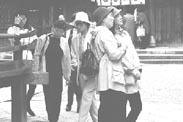The third wind
 In japan , "the land of paradoxes', as Masafumi Nagao, a professor at the Centre for the study of International Cooperation in Education at Hiroshima University, puts it, the third sector that constitutes the non-profit and the non-governmental sector "is not without history'. The first and the second sectors comprise the government and the industry respectively, which are considered to be very strong.
In japan , "the land of paradoxes', as Masafumi Nagao, a professor at the Centre for the study of International Cooperation in Education at Hiroshima University, puts it, the third sector that constitutes the non-profit and the non-governmental sector "is not without history'. The first and the second sectors comprise the government and the industry respectively, which are considered to be very strong.
According to Nagao, who has authored a book entitled The Third Sector in Japan: Paradoxes, Challenges and Opportunities , the military was the dominant force between the mid-19th century and the World War- ii . Its main concern was national security. Importance was also paid to building a modern nation. However, democratic rights were not given to the people liberally, though feudal class distinction was extinguished and universal education was initiated. "The institution of education is one of the reasons for development in the country,' says Tadashi Ogawa, director of the Japan Foundation in New Delhi.
The second period, beginning after the World War- ii , was dominated by the private enterprise sector, which played an important role in improving the economy. "This period called for survival and reconstruction... and pursuit of greater material welfare,' Nagao observes. These were characterised by innovations such as "joint efforts among enterprises and formation of industry associations for technology and sharing market information', he points out. As development was not just for fast economic growth but also for greater equity, more than three-fourths of Japan was already in the middle class by the mid-1960s. Nagao says the economy was already growing at 10 per cent by 1973 when the oil crisis shook the world.
"Now a new wind is blowing,' says Nagao. Quantitative growth no longer being the issue, more importance is given to quality. "Perhaps this is simply a sign of affluence,' he says. There is also an increasing concern about decentralisation of socio-economic pursuits. The efficiency of the first sector in meeting the demands of the society was often questioned and, as a result, this sector's importance reduced in the 1980s. "Traditional public sector, too, could not comply with the demands of society,' says Ogawa. Hence, says Nagao, "this is the time for the third sector to grow and act as agents of the new wave of institutional innovations.'
Public participation
Citizens' activities play a crucial role in the history of environmental conservation. Pollution control in Japan is no exception. Protest movements initiated by the citizens became the driving force behind the government's pollution control efforts. The movements against pollution grew systematically and expanded their ties at a national level.
"People are aware that the local government is often undemocratic and ineffective,' says Ogawa. In the 1960s-70s, citizens rose in protest against pollution of air and water, filing cases in protest against polluting companies. Japan has faced many cases of violent citizen's movements with regard to pollution. This goes back to 1880. Due to citizen's complaints in Osaka city, the Osaka prefecture government issued orders to polluting sources. In the order, the word kogai or "public damage caused by pollution' was used for the first time in Japan. Passionate local protest against pollution was common even during the Meiji era, when local communities protested the emission of sulphur dioxide from copper refineries.
During the period of economic growth, there was a rise in the so-called
Related Content
- Reducing the cost of capital: strategies to unlock clean energy investment in emerging and developing economies
- India wind energy market outlook 2022-2026
- Renewable power generation costs in 2021
- Renewables 2022 global status report
- Global Offshore Wind Report 2021
- An Ocean of potential: recommendations for offshore wind development in India
